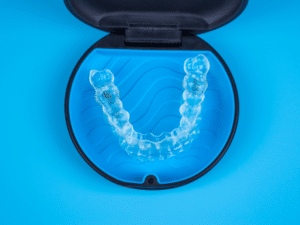Are you trying to decide between braces and aligners for your child in Indian Land, SC? The extent of their orthodontic issues could determine which treatment they need. By reading this guide, you can walk into their orthodontic appointment armed with the knowledge to make the right choice. Learn more about your child’s orthodontic options, including Invisalign vs Metal Braces Fort Mill, SC with this guide today.
WHAT IS INVISALIGN?
Invisalign is a brand of clear aligners used in orthodontic treatment to straighten teeth and correct bite issues. It is a popular alternative to traditional metal braces. Invisalign aligners are custom-made for each individual using advanced 3D computer imaging technology. The aligners are made of clear, BPA-free plastic, making them nearly invisible when worn. They are designed to fit snugly over the teeth and gently apply controlled force to move them into the desired position.
The Invisalign treatment process involves a series of aligners, with each set worn for about one to two weeks before progressing to the next set. Each new set of aligners is slightly adjusted to continue the gradual movement of the teeth.
Custom-made Clear Aligners for Effective Orthodontic Treatment
First, the orthodontist will need to take a scan of your child’s teeth. This scan allows them to create your child’s custom-made Invisalign aligners. The plastic trays are clear, BPA-free, and almost invisible. These trays are comfortable and fitted to sit around your child’s teeth. Your child will receive different aligners over the course of their treatment. The aligners will draw their teeth together, closing gaps and improving alignment issues. However, it’s important to note that Invisalign isn’t ideal for every orthodontic case.
With Invisalign treatment, your child won’t have to deal with the brackets or wires associated with traditional braces. Since they’re clear, the aligners are more discreet than braces. In fact, your child can remove their trays to eat or drink beverages besides water. To ensure effective results, your child will need to wear their aligners for 22 to 24 hours each day. This consistent wearing is crucial for the success of the treatment.
Pros Of Invisalign
- Invisalign offers several benefits for patients who seek more discretion. With Invisalign, your child won’t have to feel self-conscious about metal brackets covering their smile, as the aligners are virtually invisible. In fact, most people won’t even realize they’re wearing aligners.
- It’s important to remember that Invisalign aligners are removable, allowing your child the convenience of taking them out as needed. It’s important to remove the aligners to eat and drink. Otherwise, food particles or dyes could stain the clear plastic.
Since your child can remove their aligners alone, they won’t have to worry about food restrictions. - If you’re concerned about your child’s comfort, they might prefer Invisalign. The smooth plastic will likely feel more comfortable than metal brackets.
Cons Of Invisalign
- The duration of Invisalign treatment can vary depending on the severity of your child’s alignment issues. In most cases, treatment lasts for approximately 18 months. However, this timeline can be extended if the aligners are not consistently worn as instructed.
- Younger children may find it challenging to wear their aligners for the recommended duration each day. Their ability to comply with the necessary wearing schedule should be taken into account when considering Invisalign.
- Proper oral hygiene is crucial during Invisalign treatment. Your child will need to brush and floss their teeth each time they eat before putting the aligners back in. Failing to do so can result in the trapping of food particles between the teeth and aligners, leading to the potential spread of bacteria and increased risk of gum disease.
- Keeping both the teeth and aligners clean is essential. Some children may find it frustrating to brush after every meal, which is necessary when wearing Invisalign. If your child struggles with maintaining this cleaning routine, metal braces might be a more suitable alternative to consider.
- It’s not uncommon for children to misplace or lose their aligners. When your child removes their trays to eat, they should always place them in a designated case. Placing aligners on a napkin or other surfaces increases the risk of accidental disposal, leading to costly replacements.
WHAT ARE TRADITIONAL BRACES?
Metal braces are orthodontic appliances used to correct dental misalignment and malocclusion. They consist of metal brackets, which are bonded to the teeth using dental adhesive, and metal wires that connect the brackets. The brackets are carefully positioned on each tooth, and the wires apply gentle pressure to gradually shift the teeth into their desired positions.
About 4 million people younger than age 18 are wearing braces. In fact, four out of every five people in braces are minors. Like Invisalign aligners, metal braces can help close the gaps between your child’s teeth. Closing these gaps can straighten their smile and keep food particles from hiding between their teeth. While the goal is the same for these two treatments, the process is a little different. Traditional braces use wires and brackets to draw the teeth together. The brackets adhere to your child’s teeth, while a metal wire runs between the brackets.
Pros Of Metal Braces
- When choosing between Invisalign vs braces, it helps to take your child’s age into account.
- If your child is younger and can’t handle the responsibility of aligners, consider metal braces instead. Your child can’t lose their braces! They won’t need to switch out their aligners over the course of the treatment, either.
- Remember, forgetting to wear their aligners can delay your child’s treatment. With braces, you won’t have this concern.
- Instead, you’ll have peace of mind that their treatment is on track to end on time.
- Your child might have a shorter treatment time with traditional braces.
- Unlike Invisalign aligners, braces are customizable accessories. Your child can choose different colors for their brackets. For younger children, that’s the best part of the treatment.
Cons Of Metal Braces
- It’s important that your child maintains their oral hygiene during the course of either treatment. If they don’t brush and floss, food particles could get trapped between their brackets.
- Your child might complain about discomfort. It’s normal to feel uncomfortable during the first few weeks.
- They might need time to adjust to having wires and brackets in their mouth.
- Your child will need to understand there are food restrictions to follow, too. With metal braces, they can’t eat sticky candies or foods.
- Some children struggle to follow instructions after their braces treatment. Once they get their braces removed, they might need to wear a retainer. Failing to wear a retainer at night could impact the results of their treatment later on.
Invisalign vs Metal Braces: your path to a straighter smile
Although both treatments (Invisalign Vs Metal Braces) are effective in addressing alignment issues, they do have some distinctions. For younger children, metal braces might be a more suitable option. Traditional braces are particularly beneficial for patients with more severe alignment issues.
Indian Land Orthodontics
If you’re trying to decide between braces and aligners for your child in Indian Land, SC, it’s important to consider the extent of their orthodontic issues. Indian Land Orthodontics is a trusted and reliable dental practice dedicated to providing exceptional orthodontic care in Indian Land, SC, and the surrounding areas. With their team of highly skilled orthodontists and state-of-the-art technology, they are committed to helping patients achieve beautiful and healthy smiles.
Want to discuss your child’s oral health needs? We’re here to help! Contact us today to schedule your free consultation appointment.


